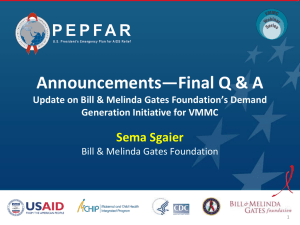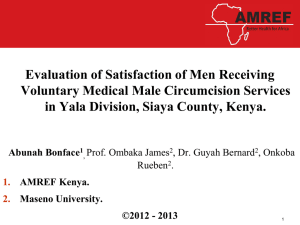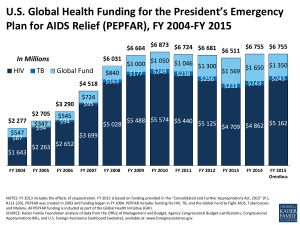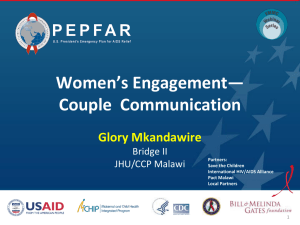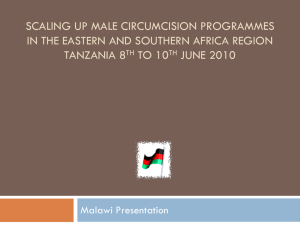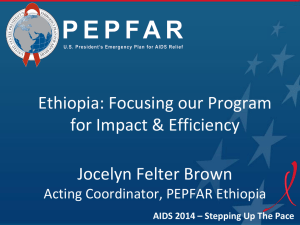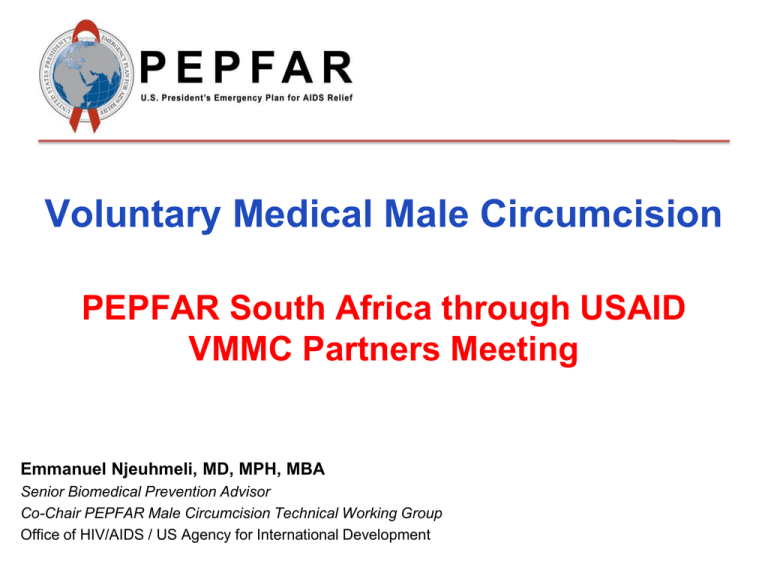
Voluntary Medical Male Circumcision
PEPFAR South Africa through USAID
VMMC Partners Meeting
Emmanuel Njeuhmeli, MD, MPH, MBA
Senior Biomedical Prevention Advisor
Co-Chair PEPFAR Male Circumcision Technical Working Group
Office of HIV/AIDS / US Agency for International Development
Voluntary Medical Male Circumcision
for HIV Prevention
Scientific Evidence
Over 50 studies to date, most of them in Africa
• Epidemiological
• Biological
– Inner membrane surface of the foreskin highly vulnerable to HIV infection
– Up to nine times more vulnerable than cervical tissue
• Three RCTs
– South Africa, Uganda and Kenya
Strong association between
• Lack of male circumcision
• Higher risk of heterosexual (female-to-male) HIV transmission
• MC has a strong protective effect against HIV acquisition.
• Estimated by WHO/UNAIDS to be around 60%
Male Circumcision Target Countries
20,373,693M adult 15-49 years men to be
circumcised across all 14 countries
Number of Adult 15-49 years male circumcision needed
to reach 80% coverage in 5years
5,000,000
4,333,134
4,500,000
4,245,184
4,000,000
3,500,000
3,000,000
2,500,000
1,949,292
2,101,566
1,500,000
376,795
1,000,000
345,244
377,788
500,000
40,000
-
1,912,595
1,746,052
2,000,000
1,373,271
1,059,104
330,218
183,450
Cumulative Number and Percentage of HIV Infections
Averted between 2011 to 2025 by scaling up MC
45.0%
40.0%
1,000,000
35.0%
800,000
30.0%
25.0%
600,000
20.0%
400,000
15.0%
10.0%
200,000
5.0%
-
0.0%
Percent of infections averted by MMC
Number of HIV infections averted
1,200,000
Indirect Impact on women
Importance of the Implementation Coverage
• Decreasing the MMC coverage target from 80% to 50%
results in a
– decline in the number of HIV infections averted from 3.4M to 1.1M
– In Zimbabwe from 41.7% of new HIV infection averted to 23.6% of
new HIV infection averted
• On the other hand, increasing target MMC coverage from
80% to 100% results in
– an increase in the number of HIV infections averted from 3.4M to 5M
– In Zimbabwe from 41.7% of new HIV infection averted to 50.5% of
new HIV infection averted
Importance of the Implementation Pace
• Also as expected, reducing the time to achieve 80% MMC
coverage from 5 years to 1 year leads to
– an increase in the number of HIV infections averted from 3.4M to
4.1M
– In Swaziland, from 33.9% of new HIV infection averted to 41.5% of
new HIV infection averted
– a decrease in the cost per HIV infection averted,
– and an increase in net savings per HIV infection averted.
• Increasing time to achieve 80% MMC coverage from 5
years to 10 or 15 years does the reverse.
– In Swaziland, 23.6% of new HIV infection averted for 10 years
implementation
Number of MC needed per Infection Averted
from 2011 to 2025
70
59
60
50
44
40
30
26
19
20
8
10
0
8
5
13
7
10
5
5
8
4
Number MC done as off April 2011
300,000
250,863
250,000
200,000
141,793
150,000
81,849
100,000
50,000
12,793
4,689
-
10,963
219
1,694
42,317
25,465
3,409
2,515
9,052
21,315
Achievement toward Target of 80% coverage
66%
70%
60%
50%
40%
30%
12%
20%
10%
0%
14%
4%
0%
0%
3%
1% 1%
0%
3%
4%
0%
1%
Voluntary Medical Male Circumcision
Quality Assurance
Quality Assurance (QA)?
QA is the process of evaluating a program or system
against known and accepted standards
– Define quality
– Provide basis for measuring – and recognizing – quality
– Provide guidance for improving quality
Goals of quality with MC include:
– Safety
– Efficiency and productivity to achieve impact on HIV incidence
(MC as a public health intervention)
– Provision of a minimum package of services in addition to
surgery
External Quality Assurance (EQA) for MC?
• Provides objective assessment to guide improvements
• Creates incentives for clinics to align services with national
standards and donor guidelines
• Facilitates achievement of MC service targets
• Complements WHO QA self-assessment tool
• Promotes public recognition and confidence in the MC
services provided
PEPFAR Standards for MC
In addition to public health impact and efficiency,
PEPFAR’s standards focus on
A.
B.
C.
D.
E.
F.
G.
H.
SOPs, guidelines, policies
Facilities, supplies and equipment
Clinical record keeping; monitoring and evaluation
Minimum package of services and linkages
Staffing
Surgery, including pre- and post-op and follow-up care
Communication to Clients
Waste management
Voluntary Medical Male Circumcision
External Quality Assurance in South Africa
Preliminary Findings
Emmanuel Njeuhmeli, MD, MPH, MBA
Senior Biomedical Prevention Advisor
Co-Chair PEPFAR Male Circumcision Technical Working Group
Office of HIV/AIDS / US Agency for International Development
Preliminary Findings
•
This assessment was for VMMC Site supported by
USAID only
• 14 sites was visited
–
–
–
–
•
5 Partners supporting those sites
–
–
–
–
–
•
5 in Gauteng
1 Free State
2 in KwaZulu-Natal
6 in Mpumalanga
CHAPS for 2 sites
Right to Care for 7 sites
MATCH for 2 sites
ANOVA for 2 sites
PHRU/ANOVA for 1 site
Sites were
–
–
Hospitals Public and Private
NGO
PEPFAR Standards for MC
In addition to public health impact and efficiency,
PEPFAR’s standards focus on
A.
B.
C.
D.
E.
F.
G.
SOPs, guidelines, policies
Facilities, supplies and equipment
Clinical record keeping; monitoring and evaluation
Minimum package of services and linkages
Staffing
Surgery, including pre- and post-op and follow-up care
Communication to Clients
Findings (1)
•
Not all sites have all the SOP, Guidelines, Policies and records in
place
–
–
–
–
–
–
–
–
–
–
–
–
–
–
–
–
Patient Rights Policies
Staff Job Description
Personnel files
Inform Consent Process Guidelines
HIV/AIDS Counseling and Testing Guidelines
STI Guidelines
Supplies and Equipment Inventory/Reports
Medication Inventory List
Emergency Guidelines
Waste Management Guideline and SOPs
Quality Control Register for HIV Tests
Equipment maintenance registers
Infection Prevention and Control Policies and Procedures
MC Surgery Guidelines
Complications/AE management Guideline
Other M&E Tools
Findings (2)
• Most partners don’t have those documents at site level but
keep them in their office and we have not seen them
• Some sites have developed their own SOP, guideline
documents and those adaptation does not translate
accurately the NDOH guidelines
Challenges
• Lack of specific National guidelines that sites can use or
refer to and this lead each partners to develop their own
guidelines
• Lack of WHO adverse event management guidelines
• Where national guidelines are existing , they are not
being present at site level, for example
– STI
– HTC National guideline
– Waste management
Recommendations
• Partners should use existing guidelines from WHO,
NDOH
• Partners should work with PEPFAR and the NDOH to
fill the gap on guidelines that are not developed yet
PEPFAR Standards for MC
In addition to public health impact and efficiency,
PEPFAR’s standards focus on
A.
B.
C.
D.
E.
F.
G.
SOPs, guidelines, policies
Facilities, supplies and equipment
Clinical record keeping; monitoring and evaluation
Minimum package of services and linkages
Staffing
Surgery, including pre- and post-op and follow-up care
Communication to Clients
Findings
• Most facilities have adequate and dedicated space
for male circumcision
• Sites are using existing supply chain management for
supplies and equipment
– We were not able to assess the Hospital SCMS
– We found them to be adequate in most sites
– Site keep limited stock of supplies in some sites just for one
week and we have reported stock out of some supplies in
some sites
– Some site lack of equipments
• Chairs for the waiting room, group counseling
• TV in the group counseling, waiting room and recovery room
Recommendations
• Dedication of space for VMMC is critical for site
efficiency and to reach public health impact with this
intervention
• Site space needs to be designed in respect of client
flow as described by WHO MOVE document
• Sites need to have adequate equipment
• Sites need to keep stock for at least one month to
avoid stock out
PEPFAR Standards for MC
In addition to public health impact and efficiency,
PEPFAR’s standards focus on
A.
B.
C.
D.
E.
F.
G.
SOPs, guidelines, policies
Facilities, supplies and equipment
Clinical record keeping; monitoring and evaluation
Minimum package of services and linkages
Staffing
Surgery, including pre- and post-op and follow-up care
Communication to Clients
Findings (1)
• All clinics keep records of the VMMC services provided
– In two MMC clinics, the client records were not kept on site
• Majority of the clients (>88% on average) are above the
age of 15.
• In VMMC clinics on average 5% of clients test positive for
HIV.
• Completeness of records ranges from 70% for client
history and physical examination to 100% for clients
demographic information.
Findings (2)
• The type of procedures performed in all the MMC clinics
are not recorded, however clinic managers reported that
forceps guided is the only surgical method used.
• All sites also use diathermy for hemostasis but this isn’t
recorded anywhere in the clients charts reviewed.
• Consent forms are missing in 10% of clients files.
• 50% of the files documented at least one follow up post
circumcision.
– Majority of these follow ups 75% were for clients who return to the
clinic after 2 days for their first post op reviews
– and 25% at the second day post MC.
Best Practices
• Age of clients very well reported and most of the sites request
birth certificate to verify the age of the client
• Sites requesting parents or guardians to sign consent form when
client are accompanied minors
• Standard surgical method, use of electrocautery and definition of
adverse events
• One site – uses a ONE recording format that has most of the
information that need to be completed for one client. This
approach of having one standardized recording format that has
provisions for recording demographics of the client, counseling
and testing, consent, history and physical examination, surgical
procedure note, post procedure follow up, adverse events
recording and management, referral notes will help reduce
paper work, reduce the chance of missing pages from client files
and provides opportunity to have all documents in one record
rather than multiple pages
Challenges
•
Completeness of records need to be 100% for all necessary information
–
–
–
–
–
–
–
–
•
•
•
•
Date of surgery
History and physical examination
Type of service providers
Type of surgical methods
Intro Op adverse events
Use of diathermy
Post op follow up
Adverse events
There are no standardized client record forms, HTC forms, consent forms,
referrals, adverse event reporting and management forms and post operative
care forms.
The absence of comprehensive monitoring and evaluation system for VMMC is
pushing partners to develop their own system and tools. This makes
standardized reporting and experience sharing a challenge.
In addition, the presence of multiple recording formats that are not properly
introduced to service providers caused the quality of the records to be low.
The monitoring information isn’t changed into electronic formats as expected, but
everything is done manually. This proves to be cumbersome and affects the
completeness as well as quality of data and reports.
Issues
• Standards recording and reporting tools for the national VMMC
program are not available.
• Client files kept outside MMC clinics.
• Counseling and testing
– Incomplete records in most sites
– Mandatory testing in some sites
• Consent Form
–
–
–
–
Missing consent signed forms in the client record in most sites
At least one MMC site had no consent form signed on client records
No records of parents or guardians consent for minors in the client records
Consent form for testing missing in client records in most sites
• No provincial or national adverse events management system in
place
– Monitoring of adverse events
– Management of adverse events
Recommendations
•
•
•
•
•
•
•
•
One monitoring and evaluation system for the VMMC program in RSA is critical
to effectively monitor progress, assure safety and plan for expansion.
Recording and reporting can and should be computerized and data should be
accessible for NDOH for decision making real time
Standardized recording and reporting tools needs to be developed as part of
the monitoring system
Consensus amongst partners and donors on one monitoring system,
orientation and training of providers on standardized tools are important
considerations for the VMMC programs in RSA supported BY PEPFAR
Clients records need to be kept on site
HIV Counseling and Testing is not mandatory
Consent Forms need to be signed and kept in clients file and parents
should consent for minors , consent need to be signed for testing and the
surgery
Date of Surgery, history and physical examination
–
•
•
Need to be carefully recorded in ALL clients files
Even though type of providers, use of electrocautery and surgical methods are
standard, need to be reported in client file
Adverse event
–
National or provincial adverse event monitoring and management system need to be design
and implemented
PEPFAR Standards for MC
In addition to public health impact and efficiency,
PEPFAR’s standards focus on
A.
B.
C.
D.
E.
F.
G.
SOPs, guidelines, policies
Facilities, supplies and equipment
Clinical record keeping; monitoring and evaluation
Minimum package of services and linkages
Staffing
Surgery, including pre- and post-op and follow-up care
Communication to Clients
Findings
• Generally sites visited provide the minimum package
of services:
– HIV testing and counseling,
– Risk reduction counseling,
– Screening and treatment of STIs.
• Only few sites refer clients for STI services outside
VMMC.
• Clinics Linkage to care and treatment is also
implemented in different facilities at different levels.
• VMMC clinics provide little or no information to
women and partners about the services.
• No couple counseling services are provided
Best Practices
• Discovery’- clients who test positive and CD4 count
below 350 are ‘escorted’ to care and treatment clinics
to be enrolled.
• Such active linkage between MC and other services
need to be strengthened
Challenges
• Follow up of clients after referral, according to most of the
sites, has proved challenging.
– There is no mechanism to confirm if clients actually accessed
services at the receiving end of the referrals.
– Especially referrals to care and treatment are not receiving
feedbacks about clients.
• In addition, the VMMC service has little to offer to women in
the form of access to information, opportunity to access
couple counseling and testing and risk reduction.
– Although a couple of sites reported efforts to educate women, in
general there is a lack of IEC materials that targets women and
families.
– Also providers are not trained to provide couples counseling in the
VMMC clinic.
Issues
• Clinics make decisions to circumcise clients who test
positive and have a CD4 count of >200 and < 350.
– While this cut off for CD4 along with clinical assessment
works well in all the clinics clients who, according the
national guidelines, need to be enrolled for care and
treatment as a priority are lost in favor of performing
circumcision.
– The linkage to care and treatment after circumcision is
weaker than the linkage before circumcision. clinics need
to prioritize enrollment to care and treatment over
circumcision.
Recommendations
• Active referral system need to be design and
implemented to track clients referred to other services
mainly care and treatment.
– Possible utilization of dedicated personnel (case manager, peer
educator, expert client) to provide active referral and linkage
– A recording and reporting mechanism to track and document
where clients went, when they accessed services.
– A simple SMS system to provide and or exchange feedbacks
between referring and receiving clinics can be helpful.
PEPFAR Standards for MC
In addition to public health impact and efficiency,
PEPFAR’s standards focus on
A.
B.
C.
D.
E.
F.
G.
SOPs, guidelines, policies
Facilities, supplies and equipment
Clinical record keeping; monitoring and evaluation
Minimum package of services and linkages
Staffing
Surgery, including pre- and post-op and follow-up care
Communication to Clients
Findings
• No standard composition of the site staff
• Most sites have staffs working 5 days a week but with
variation of time per day
• Physicians time is variable from part time to full time
• Some of the staffs do not provide MC counseling. They
were not trained
Best Practices
• Very motivated, hard working and competent staff.
• The site has enough number of nurses dedicated for
MC.
• A good number of counselors who are dedicated for all
types of counseling.
Challenges
• Each site have different composition of teams: MOVE
team
• Some sites have no dedicated physician(s) for MC clinic.
• Some clinic does not open full time
• Some of the staffs do not offer counseling because they
were not trained
• Most of the site have no data manager
Recommendations
• Each site need to have a standard composition of the MC
team and each MC site need to have a dedicated
physicians
– The ration of physician – nurse recommended in the WHO MOVE
document is 1 physician for 4 fixe nurses and 1 mobile nurse for 4
clients/surgical bed
– Clinic should maximize use of staff time and facility space by
having either one or two surgical team
• All the staffs working at the clinic need to be trained on
risk reduction counseling
• Each site should have a data clerk or data manager who
will be responsible for data management, record keeping
and reporting.
PEPFAR Standards for MC
In addition to public health impact and efficiency,
PEPFAR’s standards focus on
A.
B.
C.
D.
E.
F.
G.
SOPs, guidelines, policies
Facilities, supplies and equipment
Clinical record keeping; monitoring and evaluation
Minimum package of services and linkages
Staffing
Surgery, including pre- and post-op and follow-up care
Communication to Clients
Findings
• Most of the standards are met.
• Mixture of Lignocaine and Marcaine is used for Local
anesthesia. Standard dose is used for all clients
• One artery forceps broke during procedure.
• The MOVE model used by all facilities
Best Practices
•
•
•
•
•
MOVE model is applied.
Good surgical procedure.
Sterile techniques are followed
Attention to the client throughout of the procedure.
The surgical bays are very well arranged and all the
necessary equipments and the waste bins are located at
the surgical bay. This is very efficient way to minimize
contamination and maintain high level of waste
management.
Challenges (1)
• Using the standard dose for Local anesthesia instead
of weight based dosage.
• No marking of the intended point of incision is done
prior to the placement of forceps by some providers
• The recommended vertical mattresses for 3, 9 and 12
o’ clock positions are not applied by some providers
• Duration of surgery is not recorded. No clock in the
surgical bay in most sites
• Waste bins are very far from the surgical bays in
some sites, this led the nurse to run from the surgical
bay to the disposing area whenever he touches
unsterile surrounding environment.
Challenges (2)
• The recovery room for the clients is not clearly defined.
This may lead to not providing proper post op recovery
services which includes the 30 minutes observation with
taking the vitals.
• Diathermy’s inactive rod is handled by the client during
the electrocautery.
• Screening of the client is done in the surgical theatre and
is brief in some sites
• Hand cleaning is not standard for surgical procedure.
• Only ring blocking is done while administering local
anesthesia
• No segregation of medical wastes at the point of origin.
Challenges (3)
• Post op written instructions are not given to all clients.
• Partially applied surgical techniques, such as picking up
needles with fingers instead of pick up forceps.
• Task sharing is not practiced in some sites. Surgeon
does all steps of the procedure from injecting anesthesia
to final stitches. Nurses bandage the penis.
Recommendations (1)
• Weight based dosage should be used to every client. This
means that every client‘s weight should be taken during the
pre op examination.
• Marking is recommended in WHO manual, so it is also
recommended that the intended incision line is marked prior
to placement of forceps. This reduces the chance of cutting
too much of the foreskin.
• Waste bins should be kept in every surgical bay to minimize
unnecessary movements and risk of contamination.
• While the diathermy is great, the distance between the
active rod and the inactive rod is very long, since the
inactive rod is hand held by the client. The electric current
travels long distance to complete the circuit
Recommendations (2)
• The recovery room should be considered and special staff
should be available at the recovery to serve clients
according to WHO recommendations.
• Screening of all clients needs to be done prior to clearing
clients for surgical procedure. The screening should be
thoroughly done and not brief.
• Ring block with Dorsal Penile Nerve block is the
recommended techniques for administration of local
anesthesia.
• It is recommended that medical wastes are segregated from
the point of origin into infectious/hazardous and non
infectious wastes.
Recommendations (3)
• Sterile procedures and techniques should be applied throughout the
procedure as it will minimize chances of causing infections
• Efforts should be made to make sure that every client is given post op
written instructions.
• Recovery monitoring and post op care should be stressed to make sure
that every client access these services.
• Duration of the procedure is one of the standards for MMC (and any
other surgical procedure). It is also important to provide each surgical
bay with wall clock.
• There is a need to implement MOVE model for efficiency and to
maximize surgeon’s time. This will increase the clients’ volume.
• If surgery is done under sterile techniques, there is no need for routine
antibiotics as post op prophylaxis.
PEPFAR Standards for MC
In addition to public health impact and efficiency,
PEPFAR’s standards focus on
A.
B.
C.
D.
E.
F.
G.
SOPs, guidelines, policies
Facilities, supplies and equipment
Clinical record keeping; monitoring and evaluation
Minimum package of services and linkages
Staffing
Surgery, including pre- and post-op and follow-up care
Communication to Clients
Best Practices (1)
• Several best practices were observed, and these standards
should be celebrated and continued.
– Many of the clinics have strong outreach, and demand for VMMC
services is strong overall.
• The majority of the clinics display signage on VMMC, HIV prevention, risk
reduction, etc.
• Most of the clinics exhibit signage outside of the VMMC facility, and
eleven of the twelve clinics display ‘Brothers for Life’ posters inside their
clinics.
• Most of these facilities also offered ‘Brothers for Life’ pamphlets/flyers
and/or other take-away IEC materials on VMMC and HIV prevention.
Best Practices (2)
• Several best practices were observed, and these standards
should be celebrated and continued.
– Several components of the group session and the individual pre- and
post- HIV testing and counseling sessions were excellent overall.
• In all group counseling sessions, counselors made clients feel
comfortable, managed group dynamics effectively, and encouraged
group interaction.
• Most group counselors used teaching aids such as pictures and props,
and the vast majority demonstrated correct usage of male condoms and
offered complimentary male condoms to clients.
• All group counselors observed discussed the required six weeks of
abstinence following VMMC.
– Lastly, all sites offering HCT services insured privacy by providing
private rooms for individual HIV testing and counseling.
Challenges (1)
• IEC materials
– Although many clinics display signs outside of the clinic facility,
most fail to mention VMMC’s effect on HIV prevention.
– Many signs are not visible from the street. Therefore, clients need
to enter the facility grounds to realize that VMMC services are
offered on-site.
– Most facilities do have some type of IEC materials, flyers and
pamphlets seemed in short supply in many clinics, especially when
taking supplies of all relevant local languages into account, and
these materials were not always being provided to clients.
– None of the sites were taking the opportunity to play video
messages on VMMC, HIV prevention, and risk reduction, even
though clients were frequently waiting at facilities for several hours
or even the better part of the day. Not utilizing a TV fails to take
advantage of a valuable messaging opportunity.
Challenges (2)
• Group and individual counseling sessions
– In general, most counseling sessions fail to repeat and reemphasize key HIV prevention and risk reduction messages such
the importance of partner testing, the partially protective nature of
VMMC, the required 6-weeks of abstinence including abstinence
from masturbation, and the importance of combining VMMC with
other HIV prevention strategies in order to stay negative.
– It seems that individual counselors tend to assume that clients
previously receive the required messages in the group session and
therefore miss out on the chance to reinforce key taking points and
promote a deeper understanding.
– Only a minority of group counselors discussed the need to abstain
from masturbation. Those that did discuss masturbation were
usually prompted due to a question from a client. Including a
discussion about masturbation is critical, as clients may not
understand that masturbation will delay healing.
Challenges (3)
• Group and individual counseling sessions
– Only a few group counselors demonstrated female condoms or
offered free samples.
– Many group counselors failed to explain that STI screening was a key
criterion for determining eligibility for VMMC.
– In certain sites, the space for group counseling is inadequate. A few
clinics offer group settings in the lobby – a space that is extremely
busy, with doctors, nurses, and clients going in and out. Therefore,
privacy and client attention span are major concerns. Many clients
were distracted by movement in the hallway, and several were even
called out of initial group sessions to fill out admissions paperwork.
This is troubling, because it makes it easy for individuals to miss out
on certain key messages.
– Clients who come late are not always offered group counseling
sessions, thus they miss out completely on this experience. Given
that risk reduction messages need to be repeated to have an impact
on behavior, allowing a client to skip a group session is inappropriate.
Challenges (4)
• Individual post-op counseling sessions
– While counselors did tend to discuss general wound care, many failed
to talk about potential adverse events or the warning signs requiring
immediate attention.
– Most post-op counselors failed to explore knowledge about HIV
transmission and prevention, discuss information about HIV/AIDS,
provide prevention counseling, stress the importance of partner
testing, repeat that VMMC is only partially protective against HIV, or
discuss a personal prevention strategy.
• Counseling supervision
– The VMMC and HIV counseling supervisor is frequently shared by
other clinics and/or only available on select days of the week.
– Additionally, several challenges with correct messaging were
observed, and the lack of counseling supervision could be
exacerbating this problem.
Challenges (5)
• Lastly, at several clinics, clients receive counseling services
on the other side of the hospital rather than at the VMMC
clinic. Therefore, it is difficult to assess whether or not the
quality standards are being adhered to and if the messaging
if consistent and appropriate.
Recommendations (1)
• Male Circumcision Promotion Efforts
– The VMMC program in South Africa should adopt a National branding
– Each clinic should have a sign outside which is visible from the
street, not just inside of the hospital or facility, which mentions VMMC’s
proven effect on HIV prevention.
• IEC
– Development of standard set of IEC materials needed at site level to be
use by all sites
– standardized videos should be produced for VMMC to ensure
consistent messaging going forward.
– Each clinic should increase the availability of IEC materials on VMMC,
HIV prevention, and risk reduction overall and insure that each
pamphlet/flyer is available in all relevant local languages.
– Each clinic should add a TV and DVD player so that VMMC and/or HIV
prevention messages may be broadcasted during the client waiting
period.
Recommendations (2)
• The partners should consider looking into MTV’s PEPFAR-sponsored
‘Shuga’ series or other pre-prepared material so as to not miss out on this
valuable messaging opportunity.
• More effort needs to be put into matching site-specific supply with
demand.
– While certain sites were booked until September and/or sending away clients
on a daily basis, others will need to put far more effort into outreach to match
supply with demand as their capacity for VMMC increases.
• Education and Counseling Resources and Procedures
– All site should use the National HTC guidelines
– All counselors should incorporate more risk reduction and HIV prevention
messages into group and individual sessions. These key messages
should be repeated and re-enforced throughout each step of client
communication.
– All counselors must communicate that VMMC is only partially protective
and discuss the importance of combining VMMC with other prevention
strategies in order to stay negative.
Recommendations (3)
• Initial VMMC Education and Counseling
– All clients should participate in the full group sessions without
distraction, so the space and client flow at certain sites must be re-examined.
– Privacy should be insured so that the group feels comfortable to ask questions
in a safe and secure environment.
– Group counseling should incorporate specific VMMC teaching aids such
illustrative photos and props such as dildos, demonstration vulvas, etc.
– Group counselors must demonstrate correct and consistent condom use for
male and female condoms. A full demo of a female condom with a
demonstration vulva where possible will improve the condom presentation
overall.
– Group counselors must explain the 60% protective effect of VMMC, discuss
that VMMC does not directly protect clients’ partners from acquiring HIV,
communicate that STI screening is part of evaluation for VMMC, and clarify the
importance of abstaining from all form of sexual activity, including masturbation,
for six-weeks post-op.
Recommendations (4)
• Individual HIV Testing and counseling need to
–
–
–
–
–
–
–
–
Explore knowledge about HIV transmission and prevention,
Discuss information about HIV/AIDS,
Provide prevention counseling,
Stress the importance of partner testing,
Prepare the client mentally for his HIV test results before the test,
Repeat that VMMC is only partially protective against HIV, and
Discuss a personal prevention strategy with each and every client.
Counselors should highly encourage, though not mandate, clients to test for
HIV prior to VMMC.
• Post-operative VMMC Counseling need to
– Provide information on the warning signs requiring immediate attention and how
to address any potential adverse events,
– Re-emphasize the six-week period of abstinence including masturbation, and
– Remind the client that VMMC should be combined with other strategies to
prevent HIV transmission.
– There should be a private room for post-operative exams and counseling
sessions.
Recommendations (5)
• Routine Follow-up Counselors must
– discuss the partially-protective nature of VMMC and
– remind clients of the required 6-weeks of abstinence, including
abstinence from masturbation
• Gender Issues:
– More attention needs to be put into targeting women with relevant
messaging regarding VMMC and HIV prevention.
– All of the information sessions, from the initial group session to the
post-operative follow-up session, need to include messaging which
promotes respect for women and female partner(s).
– IEC materials need to target women with the benefits of VMMC and
allow them to become informed in order to support and encourage male
partners to pursue VMMC for HIV prevention.
– A comprehensive set of IEC materials needs to be compiled to ensure
that all facilities are using a comprehensive, 360 degree, standardized
communications approach targeting both men and women.
4 years ½ after WHO-UNAIDS Recommendations
“Neither the elegance of the science nor the strength of
the effect predict the ease of implementation."
David Stanton 2009
Achieving Pace & Scale
•
•
•
•
Community buy in and engagement of traditional leaders
Political Will and Country Ownership
Strategic communication
Strong Leadership and Coordination from the MOH with the National
and Provincial MC Task Force
• Enough resources for service delivery
• Technical support from partners
• Capacity to change the strategy as new information become available
– Task shifting to nurses
– Mobility of service delivery: taking services to people has proven
highly effective
– Dedication of sites with campaign style: continuous service delivery
more productive; mixed staffing models (public and private/NGO)
– Practicality: temporary services (adult MC)
– Innovation
Next Steps
• Prepare site-specific reports to share with USAID
Mission, Provincial DOH, partners and sites
• Continue the communication for improvements and
implementation of recommendations
• Finalize the Site Operational Guidance and tools in
annexes to be use at site level
• Work with the PEPFAR SA and the NDOH to define
IEC materials needed at site level and branding for the
VMMC program in South Africa
Assessment Team
•
•
•
•
•
•
Emmanuel Njeuhmeli, USAID Washington
Rebecca Fertziger, USAID Pretoria
Olga Mashia, USAID Pretoria
Pamala Horugavye, USAID Washington
Tigistu Adamu, MCHIP HIV Team Leader
Abubakari Mwini, MC Program Manager ICAP
Tanzania
• Partners and Site Managers
Many Thanks To
• The NDOH
• Provincial Department of Health in Gauteng,
Mpumalanga, Free State, and KZN
• District Managers
• Wendy Benzerga of USAID Pretoria
• PEPFAR Liaison in Gauteng, KZN, Mpumalanga and
Free State
• Hospital Managers
• Hospital Sites MC Managers
• Partners
• All the dedicated staffs
• Drivers

